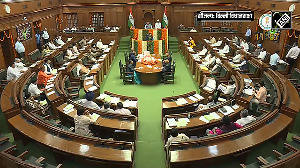 It became officially clear on Wednesday that the government had been too optimistic in framing its Budget Estimate for this financial year, at least for finances.
It became officially clear on Wednesday that the government had been too optimistic in framing its Budget Estimate for this financial year, at least for finances.
Both fiscal and revenue deficits till January shot past the respective full-year targets.
With two more months to go, the fiscal deficit overshot BE for 2011-12 by over five per cent in absolute amount.
It stood at close to 4.9 per cent of gross domestic product for 2011-12 (advance estimates), while the Budget target was to rein it in at 4.6 per cent.
The government had expected fiscal deficit to be at 4.13 lakh crore in February 2011, but it stood at 4.35 lakh crore (Rs 4.35 trillion).
The excess deficit was 5.5 per cent of BE, according to data released by the Controller General of Accounts.
Meanwhile, revenue deficit, an excess of the government's current expenditure over current receipts, also surpassed BE.
It stood at Rs 3.34 lakh crore (Rs 3.34 trillion), 8.8 per cent more than Rs 3.07 lakh crore (Rs 3.07 trillion) estimated in the Budget for the entire financial year.
The Budget had estimated revenue deficit at 3.4 per cent of GDP.
But till January, it touched 3.75 per cent of GDP, estimated for the entire financial year.
Now, economists peg fiscal deficit in the range of 5.5 to 5.8 per cent of GDP.
Govinda Rao, fiscal expert and a member of the prime minister's economic advisory council, said he was not surprised as it was known fiscal deficit would exceed the target.
"Rather it could increase by one percentage point of the target, which is not a good sign at all," Rao said.
A lower real GDP growth might not give relief to fiscal deficit numbers in terms of statistical calculation, since a nominal GDP would not be less than estimated at the time of the Budget, with inflation above the nine per cent mark till November.
However, a lower growth in real GDP did affect fiscal deficit, as it dented direct tax collections.
Officials from the Central Board of Direct Taxes said direct tax collections might fall short of BE by Rs 15,000-20,000 crore (Rs 150-200 billion).
However, indirect tax collections are going as scheduled.
The government's net tax revenues stood at Rs 4.58 lakh crore (Rs 4.58 trillion) at the end of January, 69 per cent of BE of Rs 6.64 lakh crore (Rs 6.64 trillion), against 80 per cent in the corresponding period of last financial year.
The government received a blow from non-tax revenues, as it didn't get spectacular proceeds from spectrum sale as was received in 2010-11. Non-tax revenues stood at Rs 90,566 crore (Rs 905.66 billion), 72.2 per cent of BE of Rs 1.25 lakh crore (Rs 1.25 trillion) for the entire financial year, compared to 136.6 per cent till January 2010.
Proceeds from disinvestment were not up to expectations.
As such, non-debt capital receipts stood at Rs 17,968 crore (Rs 179.68 billion), 32.7 per cent of BE of Rs 55,020 crore (Rs 550.2 billion), against 71.9 per cent last year.
All eyes are now on the ONGC disinvestment, which can fetch the government over Rs 12,000 crore (Rs 120 billion).
Despite all disturbing headline fiscal deficit numbers, the government was able to rein in expenditure as scheduled.
In 2010-11, the government was also able to prune expenditure as per BE.
The government's expenditure during April to January was at Rs 10.02 lakh crore, 79.7 per cent of BE of Rs 12.58 lakh crore (Rs 12.58 trillion) for 2011-12. In the corresponding period in 2010-11, expenditure stood at the same level.












 © 2025
© 2025